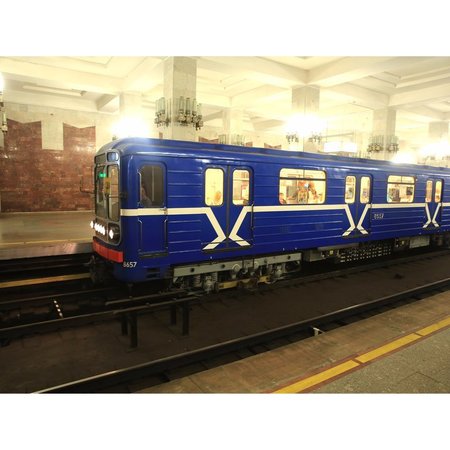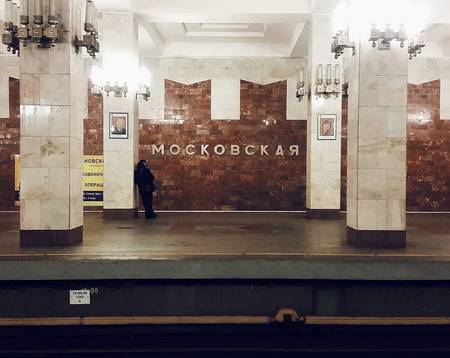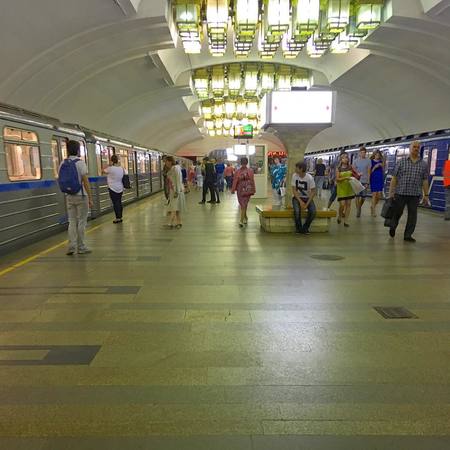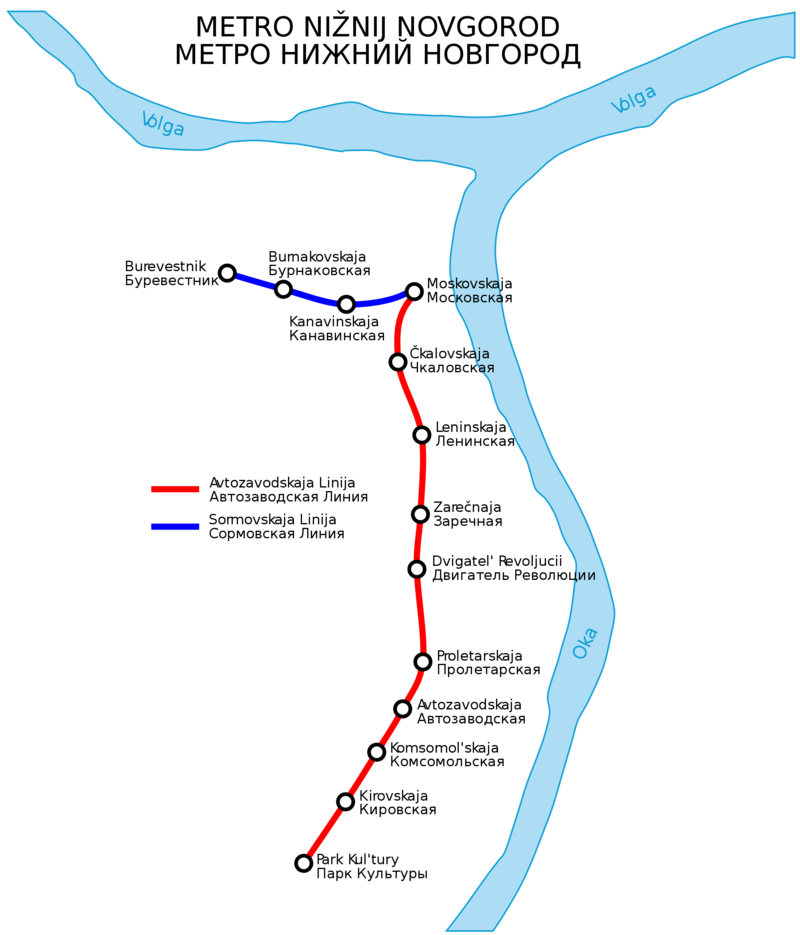Nizhny Novgorod Metro is an underground transportation system that serves the Russian city of Nizhny Novgorod. This railroad system currently offers riders two operating lines, with a total of 14 stations. It was inaugurated in 1985, becoming one of the country’s most recent developments. The system’s total route is 18.8 kilometers (11.7 miles). It has continued to expand, inaugurating its latest station in 2012. Like Russia’s other systems, its stations form a unique architectural style and design. Additionally, there are more large expansion plans. The basic system fare is 28 rubles ($US 0.48) and the operating schedule is between five and fifteen minutes in the morning and around twelve minutes after midnight.
Metros in Russia: Nizhny Novgorod
Nizhny Novgorod is a city located in the west of the Russian Federation. It is the capital of the Nizhny Novgorod Oblast and the federal district of Volga. The city is bathed in the convergence of the significant Volga and Oká Rivers. The founding of the city dates back to 1822, when Prince Yuri II of Vladimir ordered the construction for the first settlements. During the imperial time period, the city became established as an important economic center.
It wasn’t until the reign of the Soviet Union that Nizhny Novgorod was transformed into one of the most important industrial cities of the country. During this period, the city’s name changed and came to be known as Gorki, in honor of the Russian writer, Máximo Gorki. In 1990, following the fall of the Soviet Union, it reclaimed its original name.
Its historic center is extremely beautiful and it is recognized by UNESCO. Nizhny Novgorod is located in a hilly area, with rich wild vegetation. In spite of this, the highest level above sea level is 200 meters (656 feet). The average temperature during the warm months is high, hovering around a high of 18°C (64°F) and in the winter months, the temperatures average about -8°C (17.6°F).
The Metro
The Nizhny Novgorod Metro is one of Russia’s most important transportation systems. In respect to its construction, this system was inaugurated in 1985. It is the third largest in Russia, after the Moscow Metro and the Saint Petersburg Metro.
This system has 14 stations grouped together in only two lines, making the system length 18.18 kilometers (11.7 miles). The system’s rolling stock has suffered substantial variations since the metro was founded, but it has always been maintained by the Metrovagonmash company.
 Nizhni Novgorod
Nizhni Novgorod
Currently, the model that has emerged from all its variations is the 8-717/81-714, which has been extensively modernized. The previously obsolete type D train cars operated until 1993 in Nizhny Novgorod.
The annual number of passengers for 2015 was 37.24 million, indicating a daily flow of 141 thousand people. The operation of the Nizhny Novgorod’s metro falls under the city government’s administration.
Brief history
Among the objectives of the Union of Soviet Socialists Republics was the development of underground transportation systems in each of the country’s major cities. Gorki, as the city of Nizhny Novgorod was known during the USSR, surpassed a million residents, making the construction of a metro system necessary, according to Soviet requirements. Metrogiprotans, the lead company in the planning and design of Russia’s metros was responsible for the system planning, which began in 1970. The license for the construction was given in 1973, so that the design could definitively begin that year.
The project was rapidly realized because the ultimate design for all the stations had been obtained. On July 15, 1977, the USSR Cabinet Government approved the construction of the Gorki Metro which began to be carried out on December 17 of that year.
The first metro route went between the Moskovskaya and Avtozavodskaya stations and was 9.6 kilometers (6 miles) long. The construction extended until November 20, 1985, the day in which the inauguration of the first phase of the system was completed. The metro rapidly began to enjoy a series of expansions that were carried out in 1987, 1989 and 1990. There was an immense standstill at the beginning of 1993, during the time that the metro had changed its name to match the city’s name. It wasn’t until 2002, when it returned to open a new station and from there, it would have to wait until 2012.
Wikipedia Metro Map
Lines and stations
The Nizhny Novgorod Metro has two functioning lines that reach various parts of the city. Of the 14 stations, 13 are barely underground, making descent barely necessary. The others are completely surface level. In spite of its characteristics, the Nizhny Novgorod Metro was strongly criticized due to transporting only a small number of people. 2012 had barely begun when the first station in the upper part of the city was inaugurated. Its operating lines are:
Line 1: Avtozavodskaya
This is Nizhegorodsky metropoliten’s first line. It runs above ground from north to south and is identified by the color red. It has 11 stations that cover 15.1 kilometers (9.4 miles). The route between Gorkovskaya and Park Kultury stations is about 20 minutes. The trip currently begins at Gorkovskaya, the most recently built, with its inauguration in 2012.
This station can be found in the historical part of the city, near Gorki Plaza and the Kremlin. It is simply styled with columns. Inaugurated with the creation of the system in 1985, the Moskovskaya station follows this one. This is probably the system’s most important station, due to it being the only transfer point between both lines, in addition to the city’s train stations. It has columns as well. In this station, they have a brown finish.
The next station to be found on this line is Chkalovskaya. It has a simple dome and white walls. It also has the characteristics of the Leninskaya station. Both have formed part of the system since 1985.
Next is Zarechnaya station, which can be found near Lenin Avenue. Its columns are made with paved stones that mimic the ocean waves.
Next along this route is the Dvigatel Revolyutsii station, which can also be found in the Leninski district. It has large columns lined with yellowish gray marble.
Operating further down is the Proletarskaya station, near Dubki Park. It is decorated with alternating yellow and pink marble, in addition to some works made of copper.
Avtozavodskaya, located in the Avtozavodsky district is the next station on this route. It has a column design of gray and black granite marble.
Komsomolskaya immediately follows. It’s decorated with gray marble columns. The Gorki automobile plant can be found near here and the next station which is Kirovskaya. It also has gray and white marble on its surface.
The closing line is Park Kultury which is arched with white walls. As its name indicates, the station can be found near Avtozavodsky Park.
Line 2: Sormovsko-Mescherskaya
The Nizhny Novgorod Metro’s second line is identified by the color blue and carries the name Sormovsko-Mescherskaya. Altogether, its barely four stations cover a total of 4 kilometers (2.5 miles). The route runs between the Moskovskaya and Burevestnik stations for a total of five minutes. It is also the most recently constructed, in comparison to the other metro line. It was completed on December 20, 1993 with the inauguration of the Kanavinskaya and Burnakovskaya stations that connected to the already existing Moskovskaya line.
This line route begins directly at Moskovskaya station. It is the only station in the system, where one can connect between both lines and the medium and long distance trains as well.
The Kanavinskaya station can be found farther along, in an area with many commercial centers. It has a yellow ceiling and no columns. Its name can cause confusion, due to the presence of a community with the same name.
Much further along is the Burnakovskaya station which contains columns in an extremely varied combination style of blues and reds. This stop provides installations from the OKBM Afrikantov nuclear company.
This line ends with the Burevestnik station, which was inaugurated on September 9, 2002. On a lateral platform with columns, this station has a simple style made up of black and white marble. A variety of transportation methods can be taken from this station in order to reach the populated Sormovo airfield.
Connections with other systems
Nizhny Novgorod is a large city and like other large cities, it has a vast transportation system to serve every portion of the city’s geographical area. The response is to serve everyone who resides there. There are four organized transportation systems that reach the majority of the city’s geographical area.
Primarily, Nizhny Novgorod has a significant tram line. The metro specifically serves the southern industrial part of the city, of which every corner of Nizhny Novgorod is reached. Found grouped across 14 lines, its total amplitude of 76.5 kilometers is more than well renowned. It can be said that this is the main method for transporting the city’s residents. A large number of stations connect with the Nizhny Novgorod Metro.
The Moskovskaya station, which connects both metro lines, connects to various tram lines including 1, 3, 6, 7, 27 and 417. The Chkalovskaya follows. It serves lines 1, 3, 27 and 417. Further along is the Proletarskaya station, which connects lines 8 and 417. Avtozavodskaya, Komsomolskaya and Kirovskaya stations connect to the lines 8, 22 and 417. Lastly, the Park Kultury station can be found on this line. It connects to line 8. In addition to Morovskaya’s connections on the second line, the Burevestnik station connects to tram lines 6 and 7.
 Nizhni Novgorod
Nizhni Novgorod
Since Nizhny Novgorod also requires a connection to the town populations, it has a suburban railway system operated by Gorky Railways that is currently subsidized by Russian Railways. The entire system has 20 stations, grouped together on two lines. 7 are on the Sormovskaya line that ends at Pochinki. The other 14 are on Priokskaya, the system’s second line which reaches Prospekt Gagarina. Both connect to Moskovskaya, at the two metro lines points of departure.
Naturally, buses are another one of the city’s large public transportation systems. The fares tend to be very similar to metro fares and the system stations connect to at least two lines. Usually, pay is given directly to the conductor and in most cases, the stops are predetermined.
Though poorly organized, another frequently used mode of transportation in Nizhny Novgorod are the mini buses. They are often referred to as marschrutkas. This system provides mini bus service to predetermined areas and it is mostly utilized by the locals. On some occasions, the stops are not clearly defined. Lastly, there is a river station from which Aquabus water taxis can be taken and an aerial tramway connects both of the Volga River’s coasts.
Connections to the airport
The Nizhny Novgorod-Strigino International Airport is responsible for supplying all air travel to this western Russian city. It is located about 14 kilometers (8.7 miles) from the city center. Geographically, it is located outside of it, in the Avtozavodsky district. Currently, there is no railroad, metro, or suburban railway connection to the airport, although the latter is projected. However, a connection to the metro can be made from bus number 11, which connects to Park Kultury station on Line 1. There is also a route used by the marschrutkas. It is number 46 and reaches the same destination as the Nizhny Novgorod Metro.
Schedule and frequency
Nizhny Novgorod metro stations open at 5:15 am. Some of the station exits don’t open until 7:00 am. In any case, however, the stations are opened before this time. Closing is around midnight, alternating according to the station, between the times of 12:05, 12:10 and 12:15 am. Similar to opening, there are exits that close earlier varying between these times until 7:00 pm.
The metro has specific routes that include various train schedules at various stations as well as on the same line. In the case of Line 1, the longest route is the one that connects the Gorkovskaya and Park Kultury station. The first train leaves from Gorkovskaya station at 5:32 am, though there are trains at other stations that run up to 10 minutes prior. The last train arrives at Park Kultury station at 12:15 am. The frequency from opening until 7:00 am is approximately 10 minutes. It runs every six minutes until 10:00 am. From there, the frequency increases incrementally up to 12 minutes, which is maintained until 4:00 pm. It then returns to a frequency of every six minutes until 6:00 pm, in which the frequency returns to every 12 minutes until 9:00 pm. After 9:00 pm, a frequency of every 16 minutes is established until the system closes. The frequency decreases on weekends, with the first train leaving at 5:31 am and the last train leaving at 12:12 am.
At 5:20 am, the first train leaves Moskovskaya station in the direction of Burevestnik and the last train of the day reaches Burevestnik at 12:28 am. The frequency varies considerably throughout the day, beginning with every 20 minutes and changes quickly to every 12 minutes, which it is estimated to maintain until 9:00 pm, varying slightly at 7:00 pm. The frequency is every 15 minutes until midnight and after midnight, the last train leaves 28 minutes later. The frequency is even less on weekends, with the first train leaving at 5:20 am and the last train arriving at 12:27 am.
Fares, tickets and cards
Nizhny Novgorod Metro’s basic entrance fare for a complete route is 28 rubles ($US 0.48). There are no fares in this system based on the distance traveled along metro lines. There are only two payment mechanisms. In Russia, it is traditional for subway systems to use tokens as entry tickets, especially if they are going to be used on single trips. The Nizhny Novgorod Metro is no exception. The token continues to be a very important method for entry into the system.
Although popular, the tokens are problematic as they generate problems due to their similarity to low denomination coins. An additional security problem is presented as they are virtually the same as those used in the Saint Petersburg Metro. As a result, holes were made in the center of the tokens, some years ago. However, the use of public transportation cards is on the rise.
 nizhny-novgorod Metro
nizhny-novgorod Metro
These cards are getting used more over time as they make the trip more economical, starting at 26 rubles ($US 0.45). A transfer can be made to any of the city’s public transportation systems within 60 or 90 minutes of entry with these cards. It costs 1000 rubles ($USD 17.19) for the general public, while there are reduced fares for students and seniors. Still, for a much lower price of 90 rubles ($US 1.55), one can obtain an electronic rechargeable card. Its use can be more cost-effective in the long term.
System rules
- Luggage no larger than 150 centimeters (59 inches), and with a width, height and length no larger than 120 centimeters (47.2 inches) can be taken on the Nizhny Novgorod Metro. If it does exceed these measurements, one may have to purchase a luggage ticket and under no circumstances, should one have more than two suitcases.
- Keeping to the right on stairs when not walking quickly is a rule one should follow.
- Any sporting equipment such as skateboards or ski supplies must be subjected to the same rules as carry-on luggage.
- Children under the age of 7 travel for free in the system.
- Animals may be transported in cages or containers, with the exception of dogs that are fitted with a muzzle.
Future expansions
The city of Nizhny Novgorod has 8 districts, but the metro only reaches five of them. The tram network is immensely larger than the metro, but there are expansion plans to make city access more universal. One such project is the expansion of the Strelka station on the Sormoyskaya line, followed by the extension of the line to the Sormovo suburb. New stations in the city center, that specifically include Sennaya and Operny Teatr, are also in the plans.
The most ambitious construction project is on Line 3. It will be identified by the color green and have 15 stations. This line, also recognized as mountainous, will be parallel to Line 1, but on the Oká riverbank.
Tips
- In the case of suspicious packages, do not use your cell phone and notify police officials immediately.
- Inform officials in a timely manner when a passenger has any type of accident, especially when it involves falling in the subway.
- One should be aware of instructions and signs as they can vary in each station.
Notable facts
- There is only one station in the entire system for people with reduced mobility.
- The metro changed its name when the city also did, changing it form Gorki to Nizhny Novgorod.
- This system has a ghost station named Yarmarka which was discarded for the construction of the Strelka station.
Sightseeing via the Nizhny Novgorod Metro
Although it was in its time of splendor during the Soviet Union, Nizhny Novgorod was a profoundly industrious city and it currently enjoys many tourist sites that can be visited via the metro. Some of them include:
- Gorki Plaza: can be reached from Gorkovskaya station on Line 1. It forms part of the city center and can be found a few blocks from the Kremlin. It is open in the center with leafy vegetation around its borders.
- Shopping Center Respublika: is one of the major shopping centers to reference in the world of city shopping centers. It is extremely large and diverse with various options for any pocketbook. Some riders complain about parking, but this shopping center can be found next to Burevestnik station on Line 2.
- GAZ History Museum: GAZ is a major Russian automotive manufacturer with its main plant in Nizhny Novgorod. It connects to three stations on Line 1. Additionally, it has a history museum, where classic vehicles can be viewed. To reach the museum, one must get off at Avtozavodskaya or Komsomloskaya station on Line 1.
Nizhny Novgorod metro map
- Passengers/Day 109,500
- Fares: 16RUB
- 24h operation: No
- Air Conditioning: No
- Walk between platforms: No
- Driverless trains: No
- Screen Doors Platforms: No
- 16RUB
- Nizhny Novgorod Metro Official Website
Help us
If you consider that the information we provide is wrong, not accurated, outdated, translation contains errors, and you would like to help us to improve the file...you can contact us here.
Feel free to contact us if you dont find the system you're looking for and we'll add it as soon as we can!
Thank you very much!








